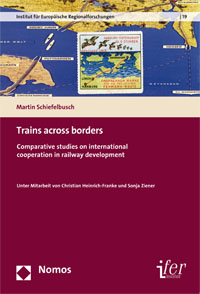Band 19: Trains across borders

Martin Schiefelbusch
Trains across borders. Comparative studies on international cooperation in railway development.
(= Integration von Infrastrukturen in Europa im historischen Vergleich, Bd. 4, Eisenbahn),
Nomos 2013.
Introduction:
Crossing borders - a simple and complicated task
Whoever travels in Europe these days will often fail to notice the passing from
one country to another, unless he or she looks out intentionally for the rather
small square blue signs with the name of the country into which one is entering.
Those travelling by air, rail or ship will usually not even be able to detect these
and have to look out for subtle differences in signage, the design of infrastructure,
symbols or advertisements and of course language to find out in which
country they are. With border controls removed inside the so-called Schengen
area, traffic flows freely across much of the continent. Transport is one of many
fields where the European Union, the big project of uniting the continent in a
peaceful way whose foundations were laid in the 1950s, can now be experienced
in a concrete way.
This freedom of movement enjoyed today is both a political and a technical
and societal achievement. The times where nation states sought to control and
restrain international movement (for various reasons) are not that far back in history.
There always was some cross-border mobility, with a few exceptions like
the Iron Curtain during the coldest part of the Cold War. But to accept crossborder
as equally valuable to domestic movement is a fairly recent development.
Furthermore, cross-border mobility also had to be provided for in the design of
the transport system. Technical standards, harmonised procedures, direct fares
and other features of easy international travel did not develop automatically.
Sometimes the foundations for such integrated solutions were laid by copying
them from a neighbouring country or the company who used them first. But at
least as often governments, manufacturers and operators thought about solving
problems on their own, in their respective areas, only to find out later that some
common standard was necessary to provide through services efficiently.
The railways were the dominant mode of transport from the mid 19th to mid
20th century, and contributed significantly to the emergence of the modern society,
the industrial economy and thus also the notion of mobility as an integral part
of life. Railway lines covered all of Europe by the 1860s, became linked together
and formed an ever tighter network until the maximum was reached in the 1920s.
Even after the following closures of many secondary lines, there is still a comprehensive
network across the continent. Road and air transport only developed
much later.
Considering this temporal advantage, it is surprising that rail is today the
mode of transport most negatively affected by the existence of borders within
Europe. Although particularly suitable for long-distance (freight) transport, rail
struggles to maintain its market share. International passenger services also are
under continuous threat - the traditional long-distance trains have largely disappeared
as a result of coach and air competition, and new high-speed corridors are
developed first for domestic services, leaving international connections as the
Achilles heel of the system. Those still travelling by rail can sometimes experience
the lack of integrative thinking: stops en route for technical reasons, having
to change trains at border stations (figure 1) or not being able to get a through
ticket are frequent examples. In other, worse, cases there may not even be the
train across the border, or passengers may be actively deterred from travelling by
hefty supplements on cross-border tickets. Since about the turn of the century,
EU politics, and the Commission in particular, has realised the need to address
these issues, but progress is amazingly slow.
